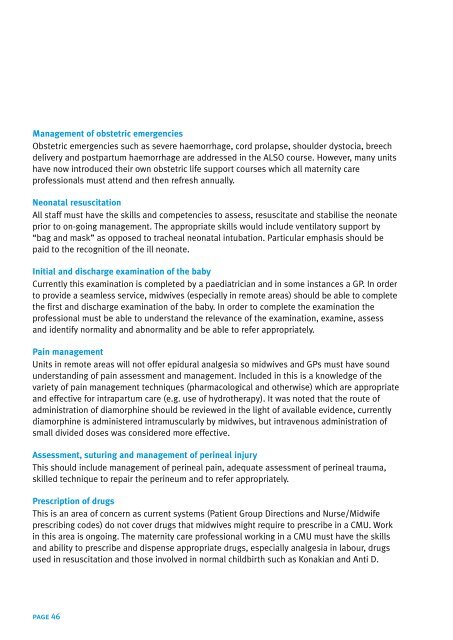Implementing A Framework for Maternity ... - Scottish Government
Implementing A Framework for Maternity ... - Scottish Government
Implementing A Framework for Maternity ... - Scottish Government
You also want an ePaper? Increase the reach of your titles
YUMPU automatically turns print PDFs into web optimized ePapers that Google loves.
Management of obstetric emergencies<br />
Obstetric emergencies such as severe haemorrhage, cord prolapse, shoulder dystocia, breech<br />
delivery and postpartum haemorrhage are addressed in the ALSO course. However, many units<br />
have now introduced their own obstetric life support courses which all maternity care<br />
professionals must attend and then refresh annually.<br />
Neonatal resuscitation<br />
All staff must have the skills and competencies to assess, resuscitate and stabilise the neonate<br />
prior to on-going management. The appropriate skills would include ventilatory support by<br />
“bag and mask” as opposed to tracheal neonatal intubation. Particular emphasis should be<br />
paid to the recognition of the ill neonate.<br />
Initial and discharge examination of the baby<br />
Currently this examination is completed by a paediatrician and in some instances a GP. In order<br />
to provide a seamless service, midwives (especially in remote areas) should be able to complete<br />
the first and discharge examination of the baby. In order to complete the examination the<br />
professional must be able to understand the relevance of the examination, examine, assess<br />
and identify normality and abnormality and be able to refer appropriately.<br />
Pain management<br />
Units in remote areas will not offer epidural analgesia so midwives and GPs must have sound<br />
understanding of pain assessment and management. Included in this is a knowledge of the<br />
variety of pain management techniques (pharmacological and otherwise) which are appropriate<br />
and effective <strong>for</strong> intrapartum care (e.g. use of hydrotherapy). It was noted that the route of<br />
administration of diamorphine should be reviewed in the light of available evidence, currently<br />
diamorphine is administered intramuscularly by midwives, but intravenous administration of<br />
small divided doses was considered more effective.<br />
Assessment, suturing and management of perineal injury<br />
This should include management of perineal pain, adequate assessment of perineal trauma,<br />
skilled technique to repair the perineum and to refer appropriately.<br />
Prescription of drugs<br />
This is an area of concern as current systems (Patient Group Directions and Nurse/Midwife<br />
prescribing codes) do not cover drugs that midwives might require to prescribe in a CMU. Work<br />
in this area is ongoing. The maternity care professional working in a CMU must have the skills<br />
and ability to prescribe and dispense appropriate drugs, especially analgesia in labour, drugs<br />
used in resuscitation and those involved in normal childbirth such as Konakian and Anti D.<br />
page 46

















